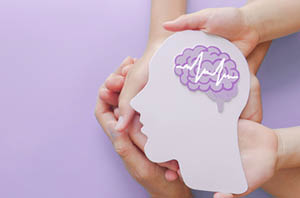Think of all the information your brain accrues over your lifetime – it’s immense. Everything from knowing the capital of Montana (it’s Helena) to where you left your reading glasses. It’s all in your noggin. So, when your brain can’t remember a bit of information (especially if you’re really needing your glasses), a common knee-jerk reaction for many people is, “I’m forgetting things – what if I’m getting Alzheimer’s?”
Why such a strong thought when it could be normal, run-of-the-mill forgetfulness? Because Alzheimer’s Disease is scary. It is the most common form of dementia, many families have seen the firsthand results of a diagnosis, and the number of cases is on the rise. Someone who does not have Alzheimer’s may forget where they put their glasses; a person with Alzheimer’s may forget what the glasses are used for.
What is Alzheimer’s (and What it isn’t)
There is Alzheimer’s and then there are a myriad of other reasons and disorders with similar symptoms. Mental illness is very commonly brought up with Alzheimer’s as they both affect the brain, but the two are very different conditions.
- Alzheimer’s Disease (AD). Alzheimer’s is an irreversible brain disease or progressive neurological disorder. It is the most common form of dementia – the name used to describe a large group of illnesses that deteriorate mental function. The American Psychiatric Association describes AD as “a group of symptoms that lead to a decline in mental function severe enough to disrupt daily life.” The disease causes problems with cognitive functioning (thinking, remembering, reasoning) and behavioral abilities.
- Mental Illness. The confusion here is that some mental illnesses can be symptoms of AD. The CDC notes that serious symptoms of depression occur in up to 50 percent of older adults with Alzheimer’s and about 30 percent of adults with anxiety disorders. Differentiating between AD and mental illness is also confusing as some symptoms are similar. Late-onset bipolar disorder and late-stage AD both can present as agitation, delusions, and manic behavior, while late-onset schizophrenia and late-stage AD can both include hallucinations and paranoia.
- Other Disorders That Can Mimic AD. Not all dementias are Alzheimer’s. Other non-AD dementias include Lewy body dementia, frontotemporal disorders, and vascular dementia. Medical conditions are also known to imitate aspects of AD like thyroid conditions, vitamin deficiencies, reactions to medications, and delirium (a temporary state of confusion or disorientation). Other problems with memory, thinking, and reasoning can be attributed to stroke, Parkinson’s Disease, HIV infection, Huntington’s disease, and traumatic brain injury.
Who Does AD Affect?
According to the CDC, it is the sixth leading cause of death among US adults, and the fifth leading cause of death among adults aged 65 years or older.
- The primary occurrence for AD is in those 65 and older
- For females aged 65-69 years dementia affects one person in 80 compared to one person in 60 for males
- Early-onset Alzheimer’s occurs between a person’s 30s and mid-60s and impacts an estimated five to 10 percent of people with AD
Causes of AD – A Work in Progress
Due to a continuous rise in AD patients, research is happening throughout the world to gain more insight as to the unknown causes of Alzheimer’s. These are the biggest factors, although the “why” continues to elude the experts:
- Age plays the biggest role
- Hereditary and genetic makeup play a part – some cases are caused by an inherited change in one of three genes; other research shows that different genetic components can be involved
- Most people with Down syndrome develop Alzheimer’s with the signs and symptoms appearing 10 to 20 years earlier
- Researchers are studying strong links indicating that education, diet, and environment might play a role in AD’s development
- Other factors being discussed include head trauma, air pollution, excessive alcohol consumption, poor sleep habits, lifestyle decisions, and heart health
Strong AD Symptoms
Only a doctor can diagnose the physical symptoms of AD. They reside within the brain and include abnormal plaque clumps (amyloid plaques), tangled bundles of fibers (neurofibrillary, tau, or tangles), and the loss of connections between neurons in the brain. Contact a doctor to investigate the internal markers if these symptoms are observed:
- Memory loss, wandering, getting lost
- Difficulty communicating, forgetting words, and jumbling phrases
- General confusion, impaired reasoning, and poor judgment
- Repetition in behaviors, questions, and comments
- Unable to process new information, difficulty with concentration, trouble with numbers
- Losing items, hiding possessions, blaming others for disappearances
- Inability to multitask, forgetting basic tasks such as bathing and dressing
- Personality and emotional changes, crying, apathy
- Vision and spatial issues
How is AD Diagnosed?
In the early days of AD discovery, the only way to ensure a diagnosis was a post-mortem brain examination. Thankfully, that is no longer the case, and now clinicians and researchers can diagnose Alzheimer’s Disease during life with more certainty. Many less-invasive screenings are performed to rule out Alzheimer’s. The following tests are often used to look for other diagnoses:
- Interviews with the patient, family, and friends regarding all aspects of the patient’s life, health, and noted changes
- Neuropsychological and mental status tests observe memory, problem-solving, attention span, counting, and language levels
- Medical tests such as blood, urine, reflexes, muscle tone/strength, sight, hearing, coordination, and balance
- CT, MRI, and PET scans all assist with visuals and imaging of the actual brain
Management of AD
Unfortunately, AD is treatable, not curable. Currently, treatment of Alzheimer’s focuses primarily on helping people maintain mental function, treating the underlying disease process, and managing behavioral symptoms. Several lifestyle risk factors can also be modified in an attempt at prevention or management:
- Physical. Maintain physical activity, eat a healthy diet, follow treatment guidelines for high blood pressure, diabetes, and high cholesterol, quit smoking, and limit alcohol use.
- Brain Stimulation. Studies have shown that participating in social events, reading, dancing, playing board games, creating art, playing an instrument, and other activities that require mental and social engagement help preserve skills longer and lower risks.
- Behavior Management. Common behavioral symptoms of Alzheimer’s can often be treated with drug and nondrug solutions. Research has shown that treating behavioral symptoms can make people with AD more comfortable and makes things easier for caregivers.
- Medications. The FDA has approved four medications that help slow the symptoms of AD: Razadyne, Exelon, Aricept, Namenda; Namzaric is a fifth drug and is a combo of two of the four. They may help reduce symptoms and with certain behavioral problems. However, these drugs don’t change the underlying disease process.
- Genetic Testing. This is not recommended for a routine Alzheimer’s disease evaluation except for those who have a family history of early-onset AD.
The Future of AD
With the surge of aging Baby Boomers and increased number of Alzheimer’s cases, the science community, families, and patients are clamoring for more research and treatments of AD. Worldwide, progress is being made:
- Researchers are developing tests that can measure biological signs of disease processes in the brain
- Blood tests may improve the accuracy of diagnoses and enable earlier diagnosis before the onset of symptoms
- Several disease-modifying medications are being tested in people with mild cognitive impairment or early Alzheimer’s as potential treatments. Aduhelm is the first disease-modifying therapy approved by the FDA to treat Alzheimer’s disease. An additional study is needed after approval to confirm the anticipated clinical benefit.
Reach out to Stellis Health for more information and to schedule appointments.
Additional Resources:
NIA Alzheimer’s and related Dementias Education and Referral (ADEAR) Center
Alzheimers.gov
Alzheimer’s Association
Eldercare Locator
MedlinePlus – NIH National Library of Medicine






